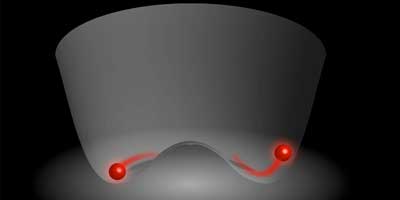| Posted: Dec 15, 2017 |
Real-time observation of collective quantum modes
(Nanowerk News) A cylindrical rod is rotationally symmetric - after any arbitrary rotation around its axis it always looks the same. If an increasingly large force is applied to it in the longitudinal direction, however, it will eventually buckle and lose its rotational symmetry. Such processes, known as "spontaneous symmetry breaking", also occur in subtle ways in the microscopic quantum world, where they are responsible for a number of fundamental phenomena such as magnetism and superconductivity.
|
|
A team of researchers led by ETH professor Tilman Esslinger and Senior Scientist Tobias Donner at the Institute for Quantum Electronics has now studied the consequences of spontaneous symmetry breaking in detail using a quantum simulator. The results of their research have recently been published in the scientific journal Science ("Monitoring and manipulating Higgs and Goldstone modes in a supersolid quantum gas").
|
 |
| In the ETH-experiment, rubidium atoms were coupled to the light waves in two resonators. In the "energy sombrero" resulting from that coupling, Goldstone and Higgs modes (red dots and arrows) were directly observed. (Image: Tilman Esslinger group / ETH Zurich)
|
Phase transitions caused by symmetry breaking
|
|
In their new work, Esslinger and his collaborators took a particular interest in phase transitions - physical processes, that is, in which the properties of a material change drastically, such as the transition of a material from solid to liquid or the spontaneous magnetization of a solid. In a particular type of phase transition that is caused by spontaneous symmetry breaking, so-called Higgs and Goldstone modes appear. Those modes describe how the particles in a material react collectively to a perturbation from the outside.
|
|
"Such collective excitations have only been detected indirectly so far," explains Julian Léonard, who obtained his doctorate in Esslinger's laboratory now works as a post-doc at Harvard University, "but now we have succeeded in directly observing the character of those modes, which is dictated by symmetry."
|
Sombrero in the quantum simulator
|
|
For that purpose, the physicists built a quantum simulator - a laboratory system, that is, in which quantum phenomena can be studied in their purest form and under controlled conditions. The quantum simulator used by the ETH researchers consists of extremely cold rubidium atoms that are exposed to several light waves.
|
|
Using two optical resonators, a coupling between the atoms and the light waves is created that causes the shape of the potential energy of the rubidium atoms to look like a rotationally symmetric salad bowl. The coordinates of the energy surface correspond to the intensity of the light in the two resonators. A laser beam that creates a so-called optical lattice can then be used to change this salad bowl-like surface in such a way that, above a critical strength of the laser beam, it starts resembling a Mexican sombrero with a bulge in the centre.
|
|
Under those circumstances, much like in the case of the cylindrical rod, spontaneous symmetry breaking occurs: just as the rod suddenly buckled in a random spatial direction, the atoms in Esslinger's experiment, which started out in the middle of the salad bowl, now all together look for a new energy minimum. That minimum can lie anywhere along the groove of the sombrero, as every point along the groove has the same energy.
|
|
That also means, however, that (energetically speaking) the atoms can be moved collectively along the groove without any energy input - this corresponds to the so-called Goldstone mode. By contrast, if one wants to nudge them radially, away from the middle of the sombrero or towards it, one has to provide the energy necessary for this Higgs mode. Again, this can be compared to a buckled rod, which is easy to rotate but hard to bend further.
|
Measuring modes in real time
|
|
"Normally, Goldstone and Higgs modes are detected indirectly via that energy", says Andrea Morales, a PhD student and member of the research team, "but we have now been able to study in real time how those modes behave when the system is perturbed".
|
|
To do so, the researchers sent a short laser pulse into one of the optical resonators and then measured the light intensity in both resonators as a function of time. This allowed them to calculate the position of the atoms inside the energy sombrero. As expected, after exciting a Goldstone mode, only the angular coordinate along the groove changed, whereas in the Higgs mode it was the radial position that varied.
|
|
For Tilman Esslinger, this direct observation of an important and widespread many-body phenomenon - which thus far could only be observed indirectly - represents one of the essential strengths of the quantum simulator: "In those synthetic quantum systems we have a pretty ideal realization of what occurs in nature - in solids and also in single molecules. The direct observation of the dynamics of the Goldstone and Higgs modes in the quantum simulator deepens our understanding of what happens in such natural systems."
|

